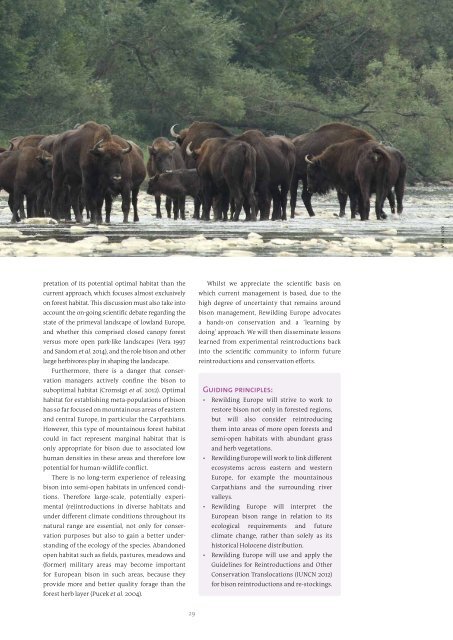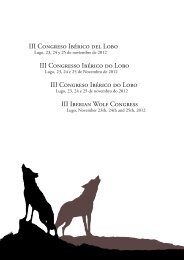Bison-Rewilding-Plan-2014
Bison-Rewilding-Plan-2014
Bison-Rewilding-Plan-2014
- No tags were found...
Create successful ePaper yourself
Turn your PDF publications into a flip-book with our unique Google optimized e-Paper software.
JOZEF FIALApretation of its potential optimal habitat than thecurrent approach, which focuses almost exclusivelyon forest habitat. This discussion must also take intoaccount the on-going scientific debate regarding thestate of the primeval landscape of lowland Europe,and whether this comprised closed canopy forestversus more open park-like landscapes (Vera 1997and Sandom et al. <strong>2014</strong>), and the role bison and otherlarge herbivores play in shaping the landscape.Furthermore, there is a danger that conservationmanagers actively confine the bison tosuboptimal habitat (Cromsigt et al. 2012). Optimalhabitat for establishing meta-populations of bisonhas so far focused on mountainous areas of easternand central Europe, in particular the Carpathians.However, this type of mountainous forest habitatcould in fact represent marginal habitat that isonly appropriate for bison due to associated lowhuman densities in these areas and therefore lowpotential for human-wildlife conflict.There is no long-term experience of releasingbison into semi-open habitats in unfenced conditions.Therefore large-scale, potentially experimental(re)introductions in diverse habitats andunder different climate conditions throughout itsnatural range are essential, not only for conservationpurposes but also to gain a better understandingof the ecology of the species. Abandonedopen habitat such as fields, pastures, meadows and(former) military areas may become importantfor European bison in such areas, because theyprovide more and better quality forage than theforest herb layer (Pucek et al. 2004).Whilst we appreciate the scientific basis onwhich current management is based, due to thehigh degree of uncertainty that remains aroundbison management, <strong>Rewilding</strong> Europe advocatesa hands-on conservation and a ‘learning bydoing’ approach. We will then disseminate lessonslearned from experimental reintroductions backinto the scientific community to inform futurereintroductions and conservation efforts.Guiding principles:• <strong>Rewilding</strong> Europe will strive to work torestore bison not only in forested regions,but will also consider reintroducingthem into areas of more open forests andsemi-open habitats with abundant grassand herb vegetations.• <strong>Rewilding</strong> Europe will work to link differentecosystems across eastern and westernEurope, for example the mountainousCarpathians and the surrounding rivervalleys.• <strong>Rewilding</strong> Europe will interpret theEuropean bison range in relation to itsecological requirements and futureclimate change, rather than solely as itshistorical Holocene distribution.• <strong>Rewilding</strong> Europe will use and apply theGuidelines for Reintroductions and OtherConservation Translocations (IUNCN 2012)for bison reintroductions and re-stockings.29



